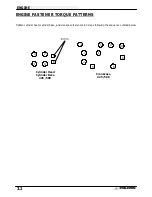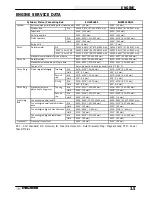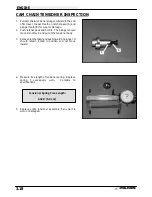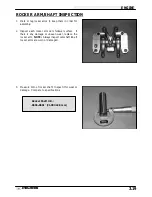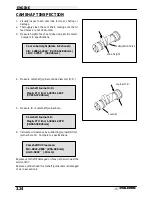
ENGINE
3.14
OIL FLOW -- EH42PL / EH50PL
The chart on page 3.15 describes the flow of oil through the EH50PL engine. Beginning at the oil tank, the oil
flows through a screen fitting in the bottom of the tank and into the oil supply hose. The feed side of the oil pump
draws oil through the hose and into the crankcase oil gallery, and then pumps the oil through another passage
to the one way valve. (When the engine is off, the one way valve closes to prevent oil in the tank from draining
into the crankcase.) The oil is pumped through a delivery pipe to the oil filter. If the oil filter is obstructed, a bypass
valve contained in the filter allows oil to bypass the filter element.
At this point, the oil is diverted in two directions. Oil is supplied to the camshaft through the left front cylinder stud,
and an oil passage in the head. Oil enters the camshaft through the PTO (L) journal. The camshaft journals, cam
lobes, and rocker arms are lubricated through holes in the camshaft. The oil lubricates the cam chain and sprocket
and drains to the sump.
The other oil path from the filter leads through a delivery pipe to the crankcase main oil gallery, which leads to
the stator plate oil passage. Here it passes through the slotted friction bearing (located in the stator plate) into
the crankshaft. An oil seal on the stator plate prevents oil from entering the stator/flywheel area. Oil travels
through the crankshaft to the crank pin, lubricating the connecting rod large end bearing directly. Oil also passes
through an oil jet (drilled orifice) in the end of the crank pin to the PTO end main bearings and counterbalancer
gears.
Residual oil from the lubrication of the crankshaft and connecting rod indirectly lubricates the cylinder wall, piston,
rings, connecting rod small end bearing, piston pin, oil/water pump drive gears, cam chain and drive sprocket,
and Magneto end crankshaft main bearing.
The one-way valve is located on the front left (PTO) side of the crankcase. The valve prevents oil in the tank from
draining into the engine sump when the engine is off. The valve mechanism consists of a plunger, return spring,
guide plug, and sealing washer. When the engine is running, oil pressure lifts the plunger off the seat, allowing
oil flow. When the engine is off, spring pressure forces the plunger against the oil passage seat, preventing oil
flow from the tank to the sump. The one-way valve requires very little maintenance. If engine oil drains into the
sump when the engine is off, inspect the valve sealing surface for debris or damage. Inspect the return spring
for distortion or damage.
Summary of Contents for Sportsman 400
Page 6: ...SPORTSMAN 400 A01CH42AC GENERAL INFORMATION 1 4 MODEL COLOR IDENTIFICATION ...
Page 21: ...Newton Meter to Pound Foot and Pound Inch GENERAL INFORMATION 1 19 TORQUE CONVERSIONS ...
Page 22: ...Newton Meter to Pound Foot and Pound Inch GENERAL INFORMATION 1 20 TORQUE CONVERSIONS ...
Page 152: ...Forward FUEL SYSTEM CARBURETION 4 2 FUEL TANK ASSEMBLY ...
Page 366: ...ELECTRONIC SPEEDOMETER WIRING DIAGRAM ELECTRICAL 10 32 ...
Page 372: ...ELECTRICAL 10 38 NOTES ...
Page 379: ...ELECTRICAL 10 39 WIRING DIAGRAM 2001 SPORTSMAN 400 ...
Page 380: ...ELECTRICAL 10 40 WIRING DIAGRAM 2001 SPORTSMAN 500 EARLY ...
Page 381: ...ELECTRICAL 10 41 WIRING DIAGRAM 2001 SPORTSMAN 500 LATE ...



